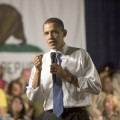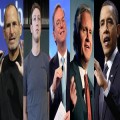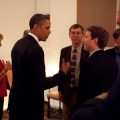President Obama is now in Colorado after an overnight stay in the Bay Area, where he attended two fundraising events and answered questions at a LinkedIn Town Hall. After landing at Moffett Field, the President went directly to the home of John Thompson, CEO of the Mountain View-based Symantec. Guests paid $2.500 per head for a chance to meet with the president and an extra $7,500 for a photo op with him. That was the cheaper of the two events.
From there he travelled to Atherton, to the home of Facebook’s Sheryl Sandberg. This event cost $35,800 a head, with $5,000 going to President Obama’s reelection campaign and $30,800 going to the DNC. The visit there was perfectly timed, considering recent news that Facebook has stepped up its lobbying efforts in Washington, including among the GOP. One of its newest lobbyists is Cathie Martin, formerly a top adviser to President George W. Bush. All told, the social networking site spent $230,000 on lobbying in the first quarter of 2011 alone—far less than Google, but almost five times as much as it spent last year.
Among the guests at the Sandberg home was pop superstar Lady Gaga, who neither wore raw meat nor arrived in an egg shaped litter carried by bare-chested men (though her heels and hair made her taller than the president). She did, however, ask the President a question about bullying, a cause she has taken on with a passion, especially following the suicide of 14-year-old Jamey Rodemeyer.
The following day was dedicated to a town hall at LinkedIn, where the president answered questions submitted online and from the audience. One of the most talked about moments was when a man identified as Douglas Edwards, who identified himself as “unemployed by choice,” asked the President to raise his taxes. Edwards, who made his money with Google, later told the press that he was part of a group called “Patriotic Millionaires for Higher Taxes.”
At LinkedIn, the President also discussed his job plan, unemployment, and other major issues facing the economy. He assured his listeners that Social Security and Medicare would continue to exist, though he recognized that Medicare poses a bigger challenge because of an aging population. Speaking of regulations, he said that he wanted to get rid of those regulations that have “outlived their usefulness,” but would protect those that ensure “clean air and clean water.”
The President admitted that his plan was limited because of economic constraints, and would not solve all of the country’s problems, notably the housing crisis. On the other hand, he believed it would have a “ripple effect” with the potential to launch and economic recovery.
 Dead Sea Scrolls Now on Google
Dead Sea Scrolls Now on Google 


